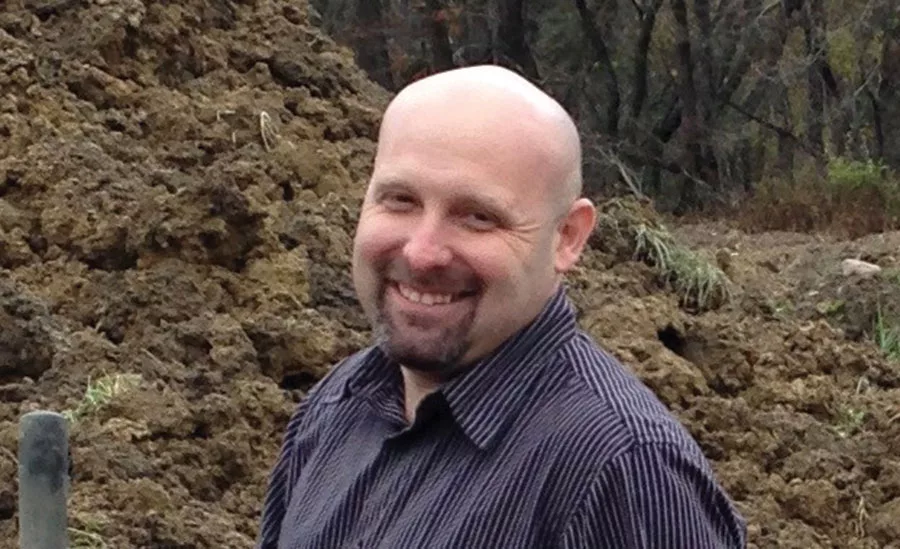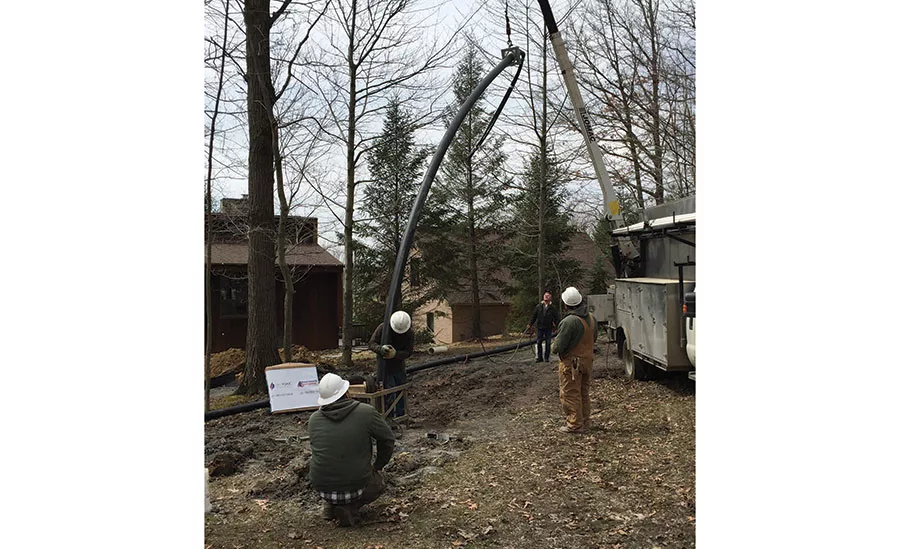Coaxial Geothermal Probe Offers Higher Fluid Flows, Better Performance




The geoKOAX pipe is fused on site. Fusing can be done one 15-foot section at a time in tight jobsites, or all at once if space isn’t a concern. Source: geoKOAX
Geothermal heating and cooling of buildings is not new. The same U-bend polyethylene pipes used 50 years ago are still commonly used today. However, several significant innovations in geothermal heat pumps and ground-loop heat exchangers have emerged in the last few years and the industry is now trying to take advantage of these recent advancements.
Energy savings from geothermal heating and cooling of buildings are well documented. However, the initial cost, mainly the drilling cost, has been the main barrier to large-scale adoption. Also, the lack of consumer knowledge and confidence due to misconceptions and errors of the past have contributed negatively by overshadowing the long-term benefits. However, all parts of geothermal systems have made significant progress and the technology has now matured to the point where it can compete on fair grounds with all other heating and cooling systems of all sizes.
Heat pumps have evolved from single-state to variable speed compressors, fans and pumps, and most of them include smarter controls and integrated sensors for monitoring, learning and real-time optimization of operating conditions. These new heat pumps can now reach unprecedented performance levels.
Similarly, amazing advancements have been seen in the ground-loop heat exchangers. The most commonly used vertical geothermal probes, namely, the single and double U-bend, have evolved to the more advanced coaxial designs with enhanced material properties and fluid flows. The geoKOAX probe, developed by geoKOAX Inc., received the 2017 commercial innovation award from the International Ground Source Heat Pump Association (IGSHPA) for a design that provides two significant advantages which translate directly into a reduction of both installation and operational costs. The probe is a 5.5-inch coaxial pipe with integrated “turbulators” that create a passively induced turbulent flow.
How Does It Work?
It is well-known that the heat transfer between a liquid in motion and a solid surface is greater when the fluid flow is turbulent as opposed to laminar. Turbulence inside a U-bend pipe is usually achieved with higher fluid flow rates, which means that the pump must work harder and therefore consume large amounts of electrical energy. In the passively induced turbulent flow of the geoKOAX probe, turbulence is created as the fluid passes through small helical threads distributed along the length of the pipe every five feet. These fixtures, called turbulators, create turbulence without significantly increasing the flow resistance. As a result, the heat transfer of the probe is maximized without much work from the fluid pump, which significantly reduces the operational cost. In addition, since the heat transfer is greater than in the traditional U-bend design, the length of the probes can be reduced, thereby reducing the installation cost.
Several other design features also contribute to the higher performance of the probe. One of them is the added surface area of contact between the exterior surface of the pipe and the ground due to its large diameter. A 5.5-inch diameter coaxial pipe provides 83 percent more total contact surface area than a ¾-inch single U-bend pipe. Note that a double U-bend configuration in 1,000-foot boreholes, which corresponds to 4,000 feet of ¾-inch pipe, would provide 9 percent more contact surface area than the coaxial pipe. However, the contact surface area of the double U-bend configuration is not as thermally efficient because of the mutual exposure and proximity of the four parallel pipes in each borehole.
Another distinction of the coaxial pipe is the greater volume of water. The coaxial configuration holds almost 20 and 10 times more water than the equivalent single and double U-bend configurations, respectively. This means that, with the same flow rate, the water travels along the length of the coaxial pipe at lower velocity, thereby providing more time for the heat exchange.
Hundreds of Installs in Europe
GeoKOAX probes have been installed throughout Europe in the last 10 years and have shown to be valuable alternatives to fossil fuel and nuclear sources for heating and cooling. GeoKOAX installed over 1,200 jobs ranging from 5-ton single family residences to large-scale 5,000-ton commercial buildings in all types of soils. In North America, the first residential installation of a geoKOAX probe was recently done in Pennsylvania. The system was designed to heat and cool the house and provide all hot water. Two 250-foot boreholes 35 feet apart were installed in series coupled with a Climate Master Trilogy heat pump. The system was sized using the geoSIM software from geoKOAX along with the GeoDesigner software from Climate Master.
A complete cost analysis of the project is not available at this time. However, the owner requested two invoices from the same installer for comparing the installation cost of the two 250-foot geoKOAX probes for a total of 500 feet of 7⅞-inch diameter borehole, to that of the equivalent U-bend configuration, which would have included five 6-inch, 200-foot holes for a total of 1,000 feet. The comparison of the two invoices shows a reduction of 37.5 percent in favor of the coaxial configuration.
The boreholes were drilled using a PDC bit. The hydrogeology of the site showed that three aquifers were penetrated and properly sealed to prevent potential cross-contamination by the advanced grout composed of a mixture of 70 percent limestone/dolomite aggregate and 30 percent bentonite. A standard winch and drill truck were used to install the two probes in four hours.
The coaxial pipe comes in 15-foot sections that are fused on site. The fusion process is either done section by section as the pipe is being inserted into the borehole (this option is used in tight lots), or the entire pipe is fused horizontally on the ground before insertion. Using the latter option, the winch truck lifts the entire pipe, which then bends into a large arch to allow insertion into the borehole as gravity takes over (see photo).
A formation thermal conductivity test was performed using the “line source” method of data analysis in the summer month and found a conductivity of 2.02 Btu/hr-ft-oF and the average thermal diffusivity, undisturbed formation temperature, and bore thermal resistance were measured at 1.41 ft2/day, 52.7oF, and 0.118 hr-ft-oF/Btu, respectively.
Pairing the geoKOAX probes with a variable speed heat pump provides an impressive coefficient of performance of 5.5 and a significant reduction of electric consumption compared to conventional heating or cooling systems. The owner decided to go with geothermal heating and cooling as a safe and comfortable alternative to burning propane gas or other fossil fuels. It is also a quiet and reliable alternative to an air-source heat pump, which can fail to provide a comfortable indoor temperature during days of extreme temperature. The geothermal system provides the energy for space heating during the entire winter at a set-point temperature between 71 and 73 degrees Fahrenheit, as well as 100 percent of hot water. The data log shows some of the data recorded during the coldest three days of the winter 2016-2017 in Pennsylvania with outdoor temperatures well below 20 degrees. The indoor temperature fluctuated around 72 degrees. At the coldest hour (i.e., 2 a.m. Dec. 16), the outdoor temperature reached 2 degrees, the leaving water temperature (LWT) reached 35 degrees at a compressor capacity of 36 percent. Overall, the system has performed as expected during the whole winter. The system will continue to be monitored in order to analyze its performance during this summer.
Looking for a reprint of this article?
From high-res PDFs to custom plaques, order your copy today!




